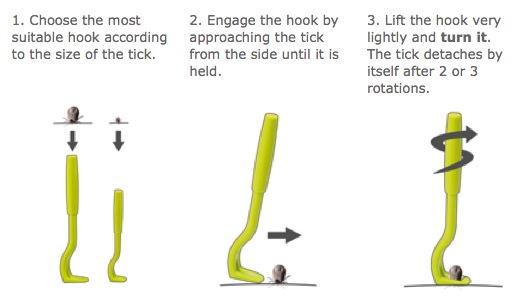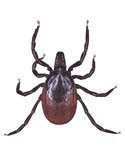
Tick Twister Smart Tick Blister Pack
Why use the O'TOM / TICK TWISTER® to remove ticks?
- It doesn’t leave the tick’s rostrum in the skin
- It doesn’t squeeze the tick’s abdomen
- It removes ticks of any size
- It removes ticks from animals and people
- It doesn’t need any chemical products (alcohol, ether,...)
- It enables a quick and painless tick removal
- It is unbreakable, hard-wearing and indefinitely reusable
The O'TOM / TICK TWISTER® doesn’t leave the tick’s mouthparts
The tick’s rostrum (the part that is embedded in the skin and improperly referred to as “the tick’s head”) is covered with backward pointing spikes that allow the tick to “anchor” in the skin. By pulling up on the tick, the spikes will rise and lock the rostrum in the skin. The tick may break leaving body parts resting in the skin and causing a painful inflammation, or an infection. By twisting, the spikes bend into the axis of rotation, and the tick is easily removed, without traction, decreasing the risks of breaking the rostrum.
The O'TOM / TICK TWISTER® doesn’t squeeze the tick’s abdomen
While removing a tick, it is essential not to compress it, reducing the risk of saliva back-flow. A tick’s saliva contains irritating substances and sometimes microorganisms that can lead to infections and/or allergies.
Tweezers and other instruments exert a pressure on the tick.
How do you remove ticks with the O'TOM / TICK TWISTER®?
Removing ticks with the O'TOM / TICK TWISTER® it as easy as child’s play.
The O'TOM / TICK TWISTER® is the best way to remove ticks completely, painlessly and safely.

What is a tick?

Ticks are external parasites that feed on blood sucked from humans or animals.
Ticks generally live in wooded or forested areas, grass, bushes, undergrowth, meadows and clearings, but can also be found anywhere there is grass (along wildlife paths, lawns, parks…).
Ticks do not jump or fly but crawl slowly.
They drop from blades of grass or twigs onto a host.
Ticks require blood to survive and reproduce.
Ticks embed themselves in their host in areas where the skin is thin (the back of the knee, the armpit, the groin) by inserting their rostrums in the skin. They secrete substances through their saliva glands, which allow them to anchor themselves solidly in order to suck blood.
Ticks on dogs and cats
You may find ticks anywhere on your dog or your cat even if you medicated your pet with a chemical product.
Ticks are most often found around the head. Indeed, dogs and cats first touch vegetation with their heads.
Ticks attached to dogs and cats are usually big because we find them late due to the animal’s hair or fur. The large O'TOM / TICK TWISTER® hook is therefore the most appropriate.
Nevertheless, for hard-to-reach areas (ears for example) or for long-haired pets, the small O'TOM / TICK TWISTER® hook may be better.
Diseases carried by ticks
Ticks may transmit many diseases to humans or animals.
Not all ticks are dangerous but they often carry pathogens (in their salivary glands or their digestive tracts).
Diseases transmitted by tick bites can cause serious illness and even death if not detected and treated immediately.
Early diagnosis is very important, if symptoms such as red spots, fever or tiredness occur; consult your doctor or your veterinarian surgeon as soon as possible.
Diseases transmitted by ticks to dogs and cats
Dogs: the main tick-borne disease that affects dogs is babesiosis ; ehrlichiosis and Lyme disease are less common.
The symptoms of babesiosis are: prostration, fever, dark urine (coffee-coloured). Without treatment, fast progression to death (2 to 3 days) can occur.
For the treatment of babesiosis, consult your veterinarian surgeon as soon as possible.
Cats: the only tick-born disease that affects cats is haemobartonellosis ; it is not very common.
- It doesn’t leave the tick’s rostrum in the skin
- It doesn’t squeeze the tick’s abdomen
- It removes ticks of any size
- It removes ticks from animals and people
- It doesn’t need any chemical products (alcohol, ether,...)
- It enables a quick and painless tick removal
- It is unbreakable, hard-wearing and indefinitely reusable
The O'TOM / TICK TWISTER® doesn’t leave the tick’s mouthparts
The tick’s rostrum (the part that is embedded in the skin and improperly referred to as “the tick’s head”) is covered with backward pointing spikes that allow the tick to “anchor” in the skin. By pulling up on the tick, the spikes will rise and lock the rostrum in the skin. The tick may break leaving body parts resting in the skin and causing a painful inflammation, or an infection. By twisting, the spikes bend into the axis of rotation, and the tick is easily removed, without traction, decreasing the risks of breaking the rostrum.
The O'TOM / TICK TWISTER® doesn’t squeeze the tick’s abdomen
While removing a tick, it is essential not to compress it, reducing the risk of saliva back-flow. A tick’s saliva contains irritating substances and sometimes microorganisms that can lead to infections and/or allergies.
Tweezers and other instruments exert a pressure on the tick.
How do you remove ticks with the O'TOM / TICK TWISTER®?
Removing ticks with the O'TOM / TICK TWISTER® it as easy as child’s play.
The O'TOM / TICK TWISTER® is the best way to remove ticks completely, painlessly and safely.

What is a tick?

Ticks are external parasites that feed on blood sucked from humans or animals.
Ticks generally live in wooded or forested areas, grass, bushes, undergrowth, meadows and clearings, but can also be found anywhere there is grass (along wildlife paths, lawns, parks…).
Ticks do not jump or fly but crawl slowly.
They drop from blades of grass or twigs onto a host.
Ticks require blood to survive and reproduce.
Ticks embed themselves in their host in areas where the skin is thin (the back of the knee, the armpit, the groin) by inserting their rostrums in the skin. They secrete substances through their saliva glands, which allow them to anchor themselves solidly in order to suck blood.
Ticks on dogs and cats
You may find ticks anywhere on your dog or your cat even if you medicated your pet with a chemical product.
Ticks are most often found around the head. Indeed, dogs and cats first touch vegetation with their heads.
Ticks attached to dogs and cats are usually big because we find them late due to the animal’s hair or fur. The large O'TOM / TICK TWISTER® hook is therefore the most appropriate.
Nevertheless, for hard-to-reach areas (ears for example) or for long-haired pets, the small O'TOM / TICK TWISTER® hook may be better.
Diseases carried by ticks
Ticks may transmit many diseases to humans or animals.
Not all ticks are dangerous but they often carry pathogens (in their salivary glands or their digestive tracts).
Diseases transmitted by tick bites can cause serious illness and even death if not detected and treated immediately.
Early diagnosis is very important, if symptoms such as red spots, fever or tiredness occur; consult your doctor or your veterinarian surgeon as soon as possible.
Diseases transmitted by ticks to dogs and cats
Dogs: the main tick-borne disease that affects dogs is babesiosis ; ehrlichiosis and Lyme disease are less common.
The symptoms of babesiosis are: prostration, fever, dark urine (coffee-coloured). Without treatment, fast progression to death (2 to 3 days) can occur.
For the treatment of babesiosis, consult your veterinarian surgeon as soon as possible.
Cats: the only tick-born disease that affects cats is haemobartonellosis ; it is not very common.
